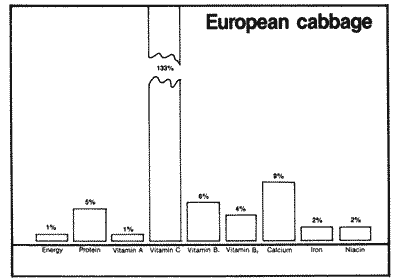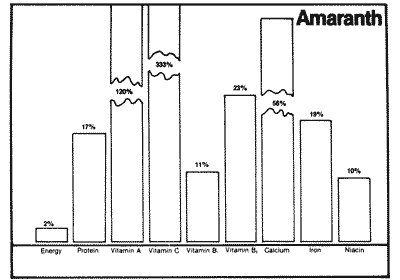
GREEN LEAVES - NUTRITIOUS PACIFIC PLANTS
SCIENTIFIC NAME: Various
FAMILY: Various
Interesting articles on Tropical Vegetables are quite difficult to obtain. As a result, when this one became available, the Editor decided to use it as the main Technical Feature for this newsletter. We are sure members will find it interesting and rewarding.
The green leaves of plants are important foods in almost all parts of the world. Scientists believe that about 1000 different plants have leaves that can be eaten. Many of these plants grow in the Pacific Islands. A few can be found or grown even on dry coral atolls.
Some kinds of green leaves grow on trees or bushes, and others on smaller, leafy plants. Trees and bushes produce leaves for a long time, provide leaves even during the dry season, need very little care, and can be used to fence in gardens. Cabbages, spinach-like green leaves, and other small leafy plants produce more leaves in a shorter time and are easier to pick than trees or bushes.
Trees, bushes, and small leafy plants are all good crops for a home garden. Growing green leaves in a home garden is a good way to make sure fresh green leaves are always available for family meals.
Sometimes green leaves can also be found in the bush or growing as weeds along farming land. Gathering and preparing traditional wild leaves is a low-cost way to enjoy the taste and food value of green leaves.
Many plants that are raised for other purposes have leaves that can be eaten, for example, taro, cassava, pumpkin, and chilli. Often, the leaves have a greater food value than the main crop. However, if too many leaves are picked from one plant, the main crop may not grow properly. Sometimes it is best to keep two plots - one for leaves and one for the other crop.
The market is another place to find green leaves, especially for people who live in towns. The traditional green leaves that can be bought at the market are usually a better buy than European lettuce and cabbage.
In some places in the Pacific, green leaves are eaten often, whereas in other places, they are regarded as 'poor man's' food or animal food. This is not true. Green leaves are one of the best foods found in the Pacific. Where possible, everyone should learn to gather, grow, or buy whatever kinds are best suited to his or her situation.
Green leaves for special needs
If possible, everyone in the family should eat some green leaves every day. In particular, children,
pregnant women, and nursing mothers need the protein, vitamins, and minerals found in green leaves. If these groups of people do not get enough iron, they are likely to get anaemia, which means they do not have enough red cells in their blood. This condition makes them feel tired and weak. It can be prevented by eating lots of iron-rich foods, such as green leaves.
People with special needs should eat each day the amounts of cooked green leaves listed below:
Babies, 4-6 months to 2 years: 1-2 tablespoons
Children, 2 years to 5 years: ¼ cup
School children : ½ cup
Pregnant women : ½ cup
Nursing mothers : ½ cup
For babies, soft leaves with no stems are best. Some good leaves for babies are: basella, aibika, ferns, and amaranth.
Since babies cannot chew well, they need help in eating green leaves. The leaves can be mashed, strained, or ground, and given by spoon to the baby. Adding a small amount of green leaves to other soft foods prepared for babies is also a good idea.
 |  |
| Percentage of daily needs of an adult woman, filled by one serving (about ½ cup after cooking) of European cabbage | Percentage of daily needs of an adult woman, filled by one serving (about ½ cup after cooking) of green amaranth |
A food for family health
Dark green leaves are one of the most nutritious foods available. Some foods have only a few of the nutrients the body needs, but green leaves have many important nutrients. Therefore, serving lots of green leaves can help make sure family meals are well balanced.
Plants make and store protein, which the body needs to grow and stay healthy. Meals that do not include other protein sources such as meat, fish, eggs, or beans should always include generous servings of dark green leaves.
Minerals come from the soil and are stored in plants. Eating green leaves gives people important minerals, such as iron which makes blood strong, and calcium which is necessary for healthy bones.
Green leaves are also a source of vitamins, including Vitamin A, Vitamin B1 Vitamin 2 and Vitamin C. Vitamins are necessary for good health. They help the body work properly.
Almost all green leaves are a good source of protein, vitamins, and minerals, but darker green leaves usually have a greater food value than lighter green leaves. For example, as the bar chart shows, dark green amaranth is more nutritious than pale green European cabbage.
Plain or fancy preparation
Green leaves are usually at their best during the hot wet months. When leaves are picked from the plant during this time, new ones will grow back quickly.
The leaves chosen for eating should be young and soft. The crisp tops and side shoots of some plants can be used. Older leaves are sometimes tough, have a stronger flavour, and need to be cooked longer.
Some green leaves, such as watercress, kangkong, creeping spinach, Chinese cabbage, and European cabbage, can be eaten raw in salads. Raw salads are a nutritious way to use green leaves since no vitamins or minerals are lost in cooking. This also saves cooking fuel.
If green leaves are to be eaten uncooked, they must first be washed thoroughly so that they do not cause sickness. They should be gently dried with a cloth or shaken dry before use.
Some other green leaves can be cooked, let cool, then used for salad. Athyrium ferns and pumpkin shoots are good this way.
Salads do not have to be prepared strictly according to recipes. Any available vegetables or other foods can be used. They taste best with a little lemon juice or salad dressing.
Whether for a salad or other dish, green leaves should never be cooked longer than necessary. They should be eaten right after cooking. Some good methods for cooking leaves are given here.
Coconut cream can be added to the green leaves for extra flavour and food value. If using the Easy Method, use thin coconut cream instead of water from the start. If using the Special Method, use thin coconut cream instead of water for the second cooking.
Eating green leaves with coconut cream, butter, meat drippings, or other fats helps the body use the Vitamin A that is in the leaves. Dishes such as salad with salad dressing or green leaves cooked in meat drippings are very nutritious ways to eat green leaves.
Green leaves can be added to any kind of soup or stew to add flavour and nutritional value, or they can be mixed into main dishes, making meat or fish go further.
Link to recipes for green leaves in recipe section.
SOME EDIBLE GREEN LEAVES OF THE PACIFIC
Use the numbers on this page to identify the leaves in the photograph.
| ENGLISH NAME | SCIENTIFIC NAME | LOCAL NAME | FOOD VALUE | DESCRIPTION OF PLANT | PREPARATION METHOD | |
| 1. | aibika, pele | Abelmoschus manihot | very good | small woody bush; many different kinds | Easy Method (no longer than 5 minutes, turn leaves once) | |
| 2. | amaranth, tropical spinach, Ceylon spinach | Amaranthus species | very good | plant with stand-up stems and spikes of flowers; many different kinds | Easy Method or Stir Frying | |
| 3. | basella, creeping spinach | Basella alba, Basella rubra | good | climbing or bushy plant with pink or white flowers | Easy Method (no longer than 5 minutes), Stir Frying or raw in salads | |
| 4. | breadfruit leaves | Artocarpus altilis | very good | large fruit-bearing tree | choose very young leaves, softened over a fire; remove stalk, then cook by Easy Method for 20 minutes | |
| 5. | cassava leaves | Manihot esculenta | very good | root-bearing shrub | choose young leaves; cook by Special Method. Do not eat raw | |
| 6. | chilli leaves | Capsicum frutescens | very good | small fruit-bearing bush | Easy Method or Stir Frying | |
| 7. | Chinese cabbage, pak choi | Brassica chinensis | good | dark green leaves with light stalks | Easy Method, Stir Frying, or raw in salads | |
| 8. | cowpea leaves* | Vigna unguiculata | good | climbing or bushy plant with long pea pods | Easy Method or Stir Frying | |
| 9. | drumstick tree, horse radish tree | Moringa oleifera | very good | small tree with yellowish-white flowers and long pods | Easy Method or Stir Frying | |
| 10. | European cabbage | Brassica oleracea (var. capitata) | fair | solid round heads of light green leaves | Easy Method, Stir Frying or raw in salads | |
| 11. | fern | Athyrium esculentum | good | large wild fern that grows in wet places | use top of stalks, split into 4 pieces, then cook by Easy Method | |
| 12. | gnetum, jointfir spinach | Gnetum gnemon | very good | small nut-bearing tree that usually grows in the bush | choose very young leaves, use Easy Method or Stir Frying. Do not eat raw | |
| 13. | Indian mulberry tree | Morinda citrifolia | very good | small tree with white flowers and bumpy fruits | choose very young leaves and use Easy Method | |
| 14. | kangkong, swamp cabbage | Ipomoea aquatica | good | trailing plant that grows in water or on dry land | Easy Method, Stir Frying or raw in salads | |
| 15. | pumpkin leaves | Cucurbita moschata | good | fruit-bearing vine | choose young shoots and leaves, use Easy Method or Stir Frying | |
| 16. | roselle, red sorrel | Hibiscus sabdariffa | good | small bush with woody branches | Easy Method or Stir Frying | |
| 17. | sweet potato leaves | Ipomoea batatas | good | root-bearing vine | Easy Method or Stir Frying | |
| 18. | taro leaves | Colocasia esculenta, Xanthosoma species | very good | root-bearing shrub | choose soft young leaves with pale stalks, use Special Method. Do not eat raw | |
| 19. | water cress | Nasturtium officinale, Roripa nasturtium-aquaticum | good | trailing plant that grows in water | collect only from clean water. Easy Method (only 3 minutes, Stir Frying or raw in salads | |
| 20. | winged bean leaves | Psophocarpus tetragonolobus | very good | climbing plant with long four-sided pods | Easy Method, Stir Frying or raw in salads | |
| * No photograph is shown | ||||||
DATE: July 1984
* * * * * * * * * * * * *
